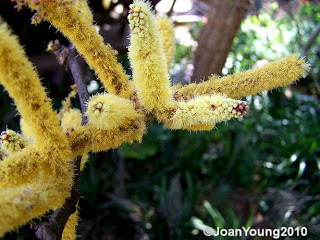Family Mimosoideae
This is a large tree with luxuriant, light green foliage, making it ideal for a big garden, avenue or park. It is also valued by farmers.
Description
Acacia galpinii is a deciduous tree, losing its leaves during the southern African winter (April-July). It is fast-growing and can reach 25-30 m. Creamy to light yellow flowers appear during the growing season (September-October). Reddish to purplish brown pods ripen during February-March. Acacia galpinii is often confused with Acacia polyacantha from which it can be distinguished by the gland on the leaf stalk: small in A. galpinii and large in A. polyacantha.
Distribution
Monkey-thorn grows naturally in open, wooded grassland, open woodland and often near streams. It is indigenous to Zambia, Zimbabwe, Malawi, northern and eastern Botswana and South Africa. In South Africa, Acacia galpinii occurs naturally in Limpopo [Northern Province] and the North-West. It is seen as an indicator of sweet veld, which retains its nutritional value in winter.
Name derivation:
The name Acacia is derived from the Greek word 'akis', meaning a point or a spike, referring to the thorns in many Acacia species. The South African species are armed with spines. Most of introduced species from Australia are spineless. The species was named in honour of Ernest Galpin (1854-1941), a plant collector. Monkeys like taking cover in its wide branches and may also eat the pods and seeds, hence the common name.
There are about 1 340 species in this genus of which 954 are indigenous to Australia, 230 to the Americas, 129 to Africa and some species scattered in Asia. This very large, pan-tropical genus occurs mainly in dry country.
Ecology and uses
Many insects such as bees and wasps visit the flowers. Ripe fruit pods burst open, releasing the seeds. Seeds are also dispersed by animals eating the pods.
Acacia galpinii is one of the trees that can survive hot and dry conditions. It makes a stunning tree along roads where there is enough space. It is an ideal tree for a big garden. In the wild the plant is grazed and used for shade during the hot summer by different animals including giraffe, kudu and elephant. Many birds often prefer nesting in this tree as it provides protection. It provides dappled shade on hot summer days, making it an ideal tree for planting on a lawn where some sun can penetrate.
Growing Acacia galpinii
Monkey-thorn is easy to propagate from seed that is not parasitized. Like other plants belonging to the Fabaceae, seed of this tree must be soaked in hot water overnight and then sown the next day. Seed must be sown in a seedling tray filled with river sand. To avoid unnecessary moisture loss, the seed can be covered with vermiculite. Seedlings are fairly fast-growing but must be protected from frost probably for the first growing season. Although it is frost-tolerant, severe frost often kills off tender young branches. The tree prefers full sun. Do not plant it too close to buildings as it has extensive roots.
Info: http://www.plantzafrica.com/plantab/acaciagalpin.htm




